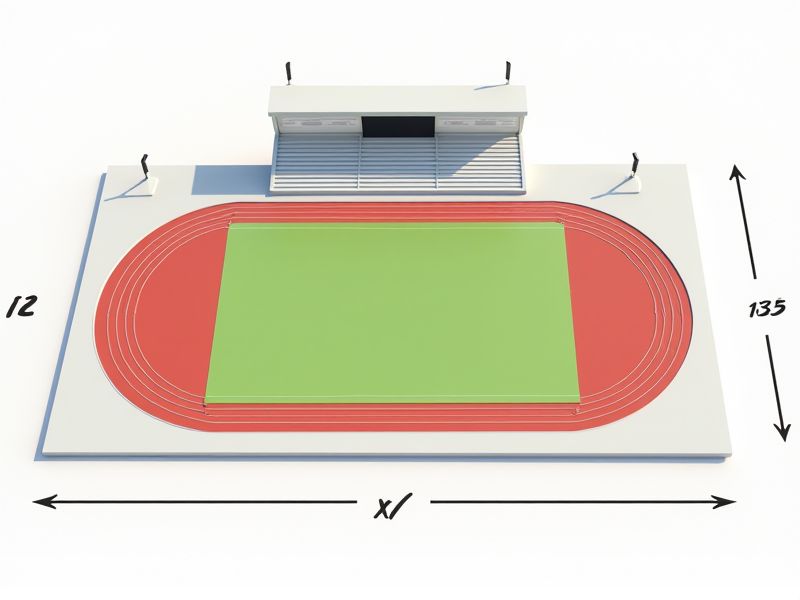
A standard track and field stadium typically features an outdoor oval running track that measures 400 meters in length for one complete lap in the innermost lane. The track is usually divided into eight lanes, each lane being 1.22 meters wide, ensuring fair competition among athletes. In the center of the oval, there's generally a grass field area used for field events such as long jump, high jump, pole vault, and throwing events. These dimensions ensure the stadium meets international regulations, allowing it to host official competitions and provide athletes with a consistent environment for performance and training.
Oval Track Length: 400 Meters
The standard oval track length for track and field stadiums is precisely 400 meters, measured around the innermost lane. This dimension ensures a uniform racing surface for athletes, facilitating events ranging from sprints to distance races. Typically, the track is divided into eight to nine lanes, each measuring approximately 1.22 meters wide, providing ample space for competitors. When planning your event, consider the optimum seating capacity for spectators, which can range from a few thousand to over 50,000 depending on the stadium's design.
Lane Width: 1.22 Meters
The standard lane width for a track and field stadium is set at 1.22 meters, ensuring consistency across competitions. This measurement facilitates fair racing conditions, allowing athletes to compete without interference from adjacent lanes. In a typical outdoor track, which features eight lanes, the overall width of the track extends to approximately 9.76 meters, accommodating both sprinters and distance runners alike. Understanding these specifications can enhance your appreciation for the meticulous design and regulation that governs the sport.
Straight Track: 100 Meters
The standard straight track in a track and field stadium measures 100 meters in length, designed for sprint events such as the 100-meter dash, where athletes showcase their speed and agility. The track surface should provide optimal traction, typically made from synthetic materials that enhance performance while ensuring safety. According to international regulations, the lane width is standardized at 1.22 meters, allowing up to eight competitors to race simultaneously. Your understanding of these specifications is crucial for athletes, coaches, and event organizers aiming for peak performance during competitions.
Long Jump Runway: 40-45 Meters
The standard length for a long jump runway in track and field stadiums is typically between 40 to 45 meters, ensuring optimal performance for athletes. This distance allows jumpers to gain sufficient speed before taking off, significantly influencing their jump distance. A well-maintained runway surface is crucial; it should be designed to reduce friction and provide adequate grip for explosive acceleration. You should be aware that the transition from the runway to the jumping board is also critical, with a standard board set at a distance of 1 meter from the pit edge, to maximize your jump potential.
High Jump Approach: 15-25 Meters
The standard high jump approach range for track and field stadiums is typically between 15 to 25 meters, allowing athletes to gain optimal speed and momentum before the jump. A well-executed approach is crucial for achieving maximum height and efficiency during the leap. Athletes should focus on their stride length and rhythm within this range to ensure a powerful take-off. Training within these parameters can significantly enhance your high jump performance and overall technique.
Pole Vault Runway: 40-45 Meters
The standard pole vault runway in a track and field stadium measures between 40 and 45 meters in length, providing athletes with the necessary distance to build speed prior to vaulting. A well-maintained runway ensures optimal performance and safety, as it is typically made of a specialized surface that enables maximum traction. The runway width is generally around 4 meters, allowing sufficient space for athletes to run and prepare for their jump. Proper design and materials used for the runway significantly impact your overall competition experience and outcomes in pole vault events.
Shot Put Circle Diameter: 2.135 Meters
The Shot Put Circle in a standard track and field stadium has a precise diameter of 2.135 meters, ensuring uniformity across competition venues. This circular area is specifically designed for athletes to project a heavy metal shot, weighing 7.26 kilograms for men's events and 4 kilograms for women's events. Proper measurements and materials are utilized to create a surface that enhances performance while minimizing the risk of injury. Adhering to these specifications is crucial for maintaining the integrity of competitions governed by organizations such as World Athletics.
Discus Throw Circle Diameter: 2.5 Meters
The discus throw circle has a standard diameter of 2.5 meters, which is essential for maintaining accuracy in competitive events. Located within a specially designed throwing area, this circular space is crucial for athletes aiming to optimize their performance. A robust surface, typically made of concrete or a non-slip synthetic material, ensures safety and efficiency during throws. Understanding these specifications can enhance your preparation and execution in track and field competitions.
Javelin Runway Length: 30-36.5 Meters
The standard runway length for javelin events in a track and field stadium is set between 30 and 36.5 meters, ensuring athletes have adequate distance for optimal acceleration before their throw. This designated area is crucial for measuring performance, as it directly influences the momentum and technique required for a successful javelin launch. Proper maintenance of the runway's surface is essential for safety and consistency, impacting your overall results. Adhering to these specifications enhances the competitive environment for athletes and ensures compliance with international standards.
Hammer Throw Cage Height: 7 Meters
The standard height for a hammer throw cage in a track and field stadium is 7 meters, ensuring optimal safety and performance. This height allows for the proper trajectory of the hammer, which can reach speeds of over 40 meters per second during a throw. Compliance with this height requirement is crucial for both athletes and officials, enabling fair competition and adherence to international standards. For any event organizer, maintaining this standard is essential for hosting official competitions recognized by governing bodies like World Athletics.
